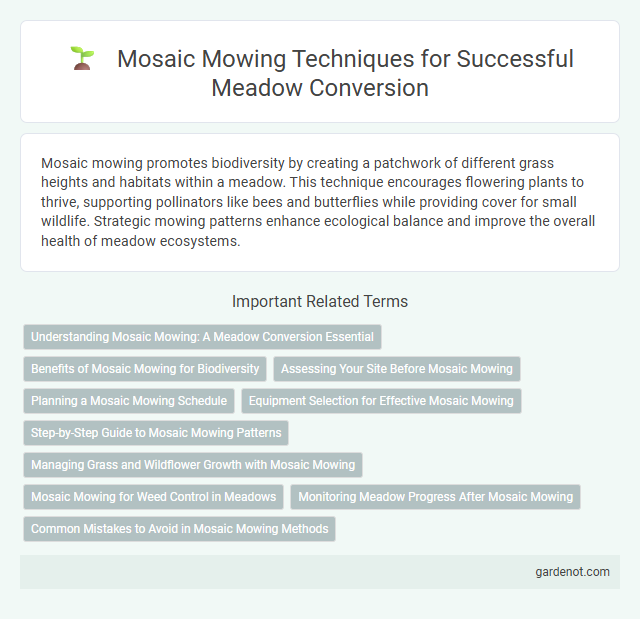Mosaic mowing promotes biodiversity by creating a patchwork of different grass heights and habitats within a meadow. This technique encourages flowering plants to thrive, supporting pollinators like bees and butterflies while providing cover for small wildlife. Strategic mowing patterns enhance ecological balance and improve the overall health of meadow ecosystems.
Understanding Mosaic Mowing: A Meadow Conversion Essential
Mosaic mowing enhances meadow conversion by creating varied sward structures that support diverse plant and insect populations, improving biodiversity. This technique involves mowing different patches on a rotational basis to maintain habitat heterogeneity essential for wildlife. Effective mosaic mowing promotes nutrient cycling and prevents dominance of aggressive species, enabling a balanced and resilient meadow ecosystem.
Benefits of Mosaic Mowing for Biodiversity
Mosaic mowing enhances biodiversity by creating varied habitats within a meadow, promoting a rich diversity of plant species and supporting diverse insect populations, including pollinators like bees and butterflies. This technique prevents dominance by aggressive grasses and allows wildflowers to flourish, increasing food sources and shelter for wildlife. The staggered mowing schedule also maintains continuous habitat availability, crucial for breeding and foraging activities of meadow-dependent species.
Assessing Your Site Before Mosaic Mowing
Assessing your site before mosaic mowing involves analyzing soil conditions, plant diversity, and existing vegetation to ensure optimal growth and habitat benefits. Identifying microhabitats and bloom periods helps plan mowing patterns that promote biodiversity and support pollinators. Mapping sensitive areas like nests or rare plants prevents damage during mowing and enhances long-term ecosystem health.
Planning a Mosaic Mowing Schedule
Planning a mosaic mowing schedule involves dividing the meadow into sections and mowing them at different times to create a patchwork of varying vegetation heights. This staggered approach promotes biodiversity by providing diverse habitats for wildlife throughout the growing season. Effective scheduling considers plant species, flowering times, and local wildlife needs to maximize ecological benefits.
Equipment Selection for Effective Mosaic Mowing
Selecting the right equipment for mosaic mowing significantly enhances meadow conversion by promoting biodiversity and efficient vegetation management. Flail mowers and rotary mowers with adjustable cutting heights are ideal for creating patchy sward structures, allowing native wildflowers and grasses to thrive alongside varied habitat features. Utilizing equipment with minimal ground disturbance features supports soil health while enabling precise mosaic patterns essential for diverse meadow ecosystems.
Step-by-Step Guide to Mosaic Mowing Patterns
Mosaic mowing involves cutting sections of a meadow in a carefully planned pattern to promote biodiversity and create visually appealing habitats. Start by dividing the meadow into distinct zones, mowing alternate patches each time to leave refuges for wildlife and encourage varied plant growth. Regularly rotate the mowed areas seasonally to maintain structural diversity that supports pollinators, birds, and small mammals throughout the year.
Managing Grass and Wildflower Growth with Mosaic Mowing
Mosaic mowing strategically manages grass and wildflower growth by varying cutting patterns and frequencies, promoting biodiversity and plant health. This technique encourages a diverse habitat structure, allowing wildflowers to bloom while preventing grass from dominating the meadow. Carefully timed mowing cycles help sustain a balanced ecosystem and support pollinators throughout the growing season.
Mosaic Mowing for Weed Control in Meadows
Mosaic mowing strategically targets invasive weeds in meadows by selectively cutting patches at different times, disrupting weed seed production and promoting native plant diversity. This technique enhances meadow health by reducing weed dominance without harming beneficial flora, thereby supporting pollinator habitats. Research shows mosaic mowing can decrease weed biomass by up to 40%, making it an effective, eco-friendly weed control method in meadow management.
Monitoring Meadow Progress After Mosaic Mowing
Monitoring meadow progress after mosaic mowing involves regularly assessing plant diversity and regrowth patterns to ensure ecological balance is maintained. Detailed observations of species composition, flowering stages, and ground cover help track the effectiveness of mosaic mowing in promoting habitat heterogeneity. Data collected supports adaptive management, optimizing mowing schedules to enhance biodiversity and meadow restoration outcomes.
Common Mistakes to Avoid in Mosaic Mowing Methods
Mosaic mowing requires careful planning to avoid common mistakes such as mowing too frequently, which can disrupt plant growth cycles and reduce biodiversity. Neglecting to vary mowing patterns can lead to habitat homogenization, diminishing the ecological benefits of the meadow conversion. Ensuring proper timing and patch selection prevents soil compaction and promotes a healthy mix of wildflowers and grasses essential for pollinators.
Mosaic mowing Infographic

 gardenot.com
gardenot.com